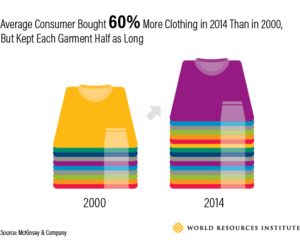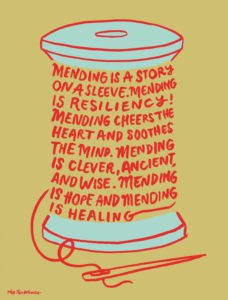The fashion industry is the second-largest polluter in the world, behind the oil industry.
I think we’ve all been there, standing in front of your closet or open dresser drawers staring blankly at the row of clothes, feeling at the same that you don’t have any clothes because you don’t like any of them at the moment. Now, more than ever, it’s as easy as a click of an icon to buy more clothes and have them delivered to your door. Yes we all need clothing to protect us from the elements, but how many clothes do we really need? Before you answer that question, let’s take a look at the true cost of fast fashion.

The fashion industry manufactures roughly between 80 billion and 150 billion pieces of clothing a year globally. That’s a lot of clothes! Keep in mind the population of the WORLD is 7.7 billion. But all that clothing comes at a high cost for the environment and the workers sewing the garments. Here are a couple of statistics to start with:

What exactly is fast fashion?
The Oxford dictionary defines it as “inexpensive clothing produced rapidly by mass-market retailers in response to the latest trends”. It’s a mass production of a short-lived fashion trend, cheaply made by exploited workers in factories thousands of miles from your nearest shopping center or online warehouse that wreaks havoc on the environment. This fashion trend gained momentum in 2000 and hasn’t slowed down since. In an article published by War on Want the author explains, “As well as earning a pittance, Bangladeshi factory workers face appalling conditions. Many are forced to work 14-16 hours a day seven days a week, with some workers finishing at 3 am only to start again the same morning at 7.30 am. On top of this, workers face unsafe, cramped and hazardous conditions which often lead to work injuries and factory fires. Since 1990, more than 400 workers have died and several thousand more have been wounded in 50 major factory fires”.
Take a look at The life cycle of a t-shirt to learn more!
How do you think this cycle of production would be different for a t-shirt made from a synthetic material like nylon?
Climate Change and fast fashion
An article in the Guardian states, “ The Intergovernmental Panel on Climate Change (IPCC) has calculated the fashion industry produces 10% of global carbon dioxide emissions every year.” Most of these emissions come from transporting the materials and clothing around the globe.
By selling clothes at a low cost, people often buy more than they need, leading to piles of clothing ending up in landfills. “Textiles are outpacing almost every waste type in our stream,” says Marisa Adler, RRS (Resource Recycling Systems) senior consultant. “It’s grown 71 percent in 15 years”. People are treating clothing as a disposal commodity because the stores stock their shelves several times a week with new styles at low prices. The average American discards 70 pounds of clothing into landfills a year!

Resources used in fashion
As mentioned in Part I of this lesson, everything we use, buy, wear, and eat contains raw materials from the earth. In the case of a t-shirt, it is either made of natural materials such as cotton, wool, hemp, and silk or synthetic materials like nylon, polyester, spandex, and modal made from plastics (from fossil fuels) and chemicals. Either way, the rate and speed at which clothing is being produced are harmful to the environment. Especially because this clothing is made in developing nations such as Bangladesh that have more relaxed or even no environmental restrictions that protect water and other ecosystems. Likewise, workers aren’t paid a living wage nor do they have protections or benefits.
Some of the chemicals used in clothing:

Impacts on the earth and communities
As shown in the video about the lifecycle of a t-shirt, every step of the way in the production impacts the environment. Here are some ways:
Water use and quality
- Cotton is a water-intensive crop to grow.
- 700 gallons of water are used to produce enough cotton for one t-shirt.
- Pesticides are applied to cotton fields potentially harming farmworkers, soil, and nearby water sources.
- Most clothes are made with dyes and chemicals that contaminate the soil and water.

Dying batik fabric in Phrae, Thailand
Carbon footprint
- Transportation across the globe during production and manufacturing produces CO2 emissions.
- Methane, a greenhouse gas, is created when clothing made of cotton is discarded in a landfill.
Waste
- Polyester, nylon, acrylic clothing made from plastic (from fossil fuels) take decades to break down in a landfill.
- Low-quality clothes are deliberately designed for a short life span and quickly end up in landfills.
- A Forbes magazine article in 2018 noted that H&M reportedly burned discarded clothing that did not sell which Greenpeace reported is a common practice for fast fashion companies.
Human Rights
- Factory workers in developing nations make well below minimum wage work in poor and dangerous working conditions with no benefits or protections.
- Pesticides are applied to cotton fields potentially harming farmworkers.
The allure of inexpensive clothing is strong, but when we look deeper into the impacts, we have to weigh the pros and cons. As more information is unearthed about the practices of fast fashion companies, they may begin to change the way they do business. Time will tell. For now, COVID-19 has given us pause on spending behaviors since we aren’t able to rush out to the nearest store to buy anything we want. I’ve watched my own spending behaviors shift because my favorite thrift stores remain shuttered during the pandemic. Perhaps we are all learning even a little bit about our consumer habits and behaviors and have to opportunity to re-imagine how we move forward when we are able. Before you go, read on for some simple alternatives to discarding clothes into the landfill and to ways to get more life out of your clothes.

What can we do about it
- Buy less! Take inventory of your closet and do a Needs and wants assessment. You might be surprised by how much you have!
- Support sustainable brands like Toms, Patagonia, or check out all of these brands.
- Purchase quality clothing that will last.
Try to repair clothing. If you can’t mend it yourself try Sew and Sew in Bellingham. - Donate clothing you don’t want or wear. Hang on to these items during COVID-19, but drop them off at second-hand stores like Goodwill, Value Village, Labels, and Buffalo Exchange when they re-open.
- Host a clothing swap with friends.
Some stores take textiles back to recycle like Ragfinery in Bellingham. - Buy second hand at Labels or Buffalo Exchange in Bellingham.
- Learn to make your own clothing.
- Use worn-out garments as cleaning rags.
- When t-shirts are produced for an event – opt out! Suggest more sustainable ways for event promotion.
What other ideas do you have?
Take Action
Most people have a pile of t-shirts around–why not make a bag out of an old t-shirt? This easy no-sew bag only requires a pair of scissors and about 15 minutes. If you have a plain colored shirt, you can decorate the bag with textile paints and add buttons or other crafty ideas you have!

Continue learning
There are lots of topics for you to choose from. Don’t stop here; move on to discover another lesson! New lessons uploaded each week.
